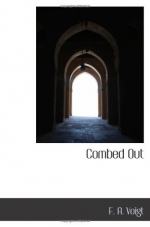Further on, to the right of the road, stood the ruins of the church. A few thick pieces of wall were still standing and a part of the steeple pointed upwards like a jagged finger. Heaped up inside were brick-fragments and tiles, together with splintered beams and rafters, riddled sheets of lead and zinc, broken chairs, twisted brass candlesticks, bits of stained glass, and here and there chunks of coloured plaster, the remains of apostolic or saintly images. One of the confessionals was still visible, although all the woodwork was shattered. Of the altar nothing could be seen. Behind a crumbling fragment of brick wall was a band of machine-gun ammunition and a heap of empty cartridge cases.
The big bronze bell lay outside the church in two pieces. The cemetery had been churned by shell-fire. The tombstones were chipped and broken. One big block of granite had been overturned by a bursting shell and the inscription was so scarred as to be illegible. The stone Christ had been hit in many places. His left hand was gone, so that He hung aslant by the other. Both His legs had been blown off at the knees and His nose and mouth had been carried away by some flying shell-fragment or shrapnel-ball. All the graves had been thrown into confusion by the violence of innumerable explosions. Bits of bone—femurs, ribs, lower jaws—lay scattered about. The hip of a soldier who had been buried in his clothes projected from the soil with the brown mass of maggot chrysalids still clinging to it. Two bent knees of a greenish-grey colour, that had only begun to decay, emerged from a patch of trodden mud.
Beyond the church, by the roadside, were the dwelling-houses. Some of them were a tangle of rafters mixed up with heaps of brick and miscellaneous rubbish—stoves, pots and pans, chair-legs, pictures, bedding, boxes, and all kinds of household articles. Others had been dispersed around. Others seemed to have been tipped up bodily, so that all their contents had been spilt into the street, and then to have been dropped back again with such an impact that they had collapsed on their own foundations. The sweet, sickly smell of bodies that had not been decaying long, and the rank, pungent smell of those that were approaching total dissolution emanated from under heaps of wreckage and from hidden cellars.
The devastation increased with every mile and the shell-holes came closer and closer together. Dead horses, shattered guns, wagons, and limbers lay overturned in the ditches. At one spot on the roadside the legs and buttocks of a man, all brown and shrivelled, slanted upwards from a deep, wide rut, many heavy wheels having passed across the small of his back.
Gradually houses, trees and bushes disappeared entirely. We reached the site of a village that before the war had sheltered several thousands of people. Nothing remained except small bits of brick mingling with the bare soil, piled up and scooped and churned and tossed by shell-fire.




